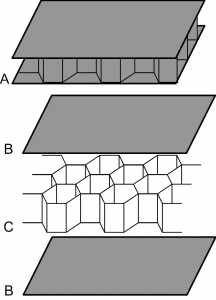If the key requirements for an application are high stiffness and low weight, core materials are probably the best and most appropriate choice. Core materials began to be used extensively in sandwich composites for their unique properties, and are mainly used for applications in aerospace, marine, wind energy, transportation and sports industry. Sandwich constructions were one of the first forms of composite structures that gained great acceptance and usage. The World War II Mosquito aircraft is said to be the first major application of sandwich panels, although there were some less spectacular uses of the sandwich principles earlier.
 A typical sandwich structured composite consists of two skins which are thin and strong, and a lightweight, softer core. Each skin may be an isotropic material or a fibre-reinforced composite laminate. The primary function of the skins is to provide the required bending and in-plane shear stiffness, and to carry the axial bending, and in-plane shear loading. The core has to be strong enough to keep the skins in their relative positions while loading, and stiff in shear so that the faces do not slide over each other. In order to force the facings and the core to cooperate and act as an integral structural part, an adhesive is used inbetween. Most of adhesives used are epoxies, modified epoxies or epoxy polyamides. The toughness of the adhesive refers to the capability to resist loads which act to separate the facings from the core under either static or dynamic conditions. Each component is relatively weak and flexible by itself, but when combined in a sandwich panel, the result is a really strong structure.
A typical sandwich structured composite consists of two skins which are thin and strong, and a lightweight, softer core. Each skin may be an isotropic material or a fibre-reinforced composite laminate. The primary function of the skins is to provide the required bending and in-plane shear stiffness, and to carry the axial bending, and in-plane shear loading. The core has to be strong enough to keep the skins in their relative positions while loading, and stiff in shear so that the faces do not slide over each other. In order to force the facings and the core to cooperate and act as an integral structural part, an adhesive is used inbetween. Most of adhesives used are epoxies, modified epoxies or epoxy polyamides. The toughness of the adhesive refers to the capability to resist loads which act to separate the facings from the core under either static or dynamic conditions. Each component is relatively weak and flexible by itself, but when combined in a sandwich panel, the result is a really strong structure.
When choosing facing, core, adhesive and any other material for an application all the properties and attributes of the material should be examined as they directly affect the success of the final product.
Sandwich composites are becoming very popular for their ability to increase stiffness, decrease weight and improve mechanical performance. Weight reduction results in a number of benefits, including lower fuel consumption, increased speed, load capacity, and reduced carbon footprint for the environment. According to engineering theory, the stiffness of a panel is proportional to the cube of its thickness. So, adding a low density core material in order to thicken the sandwich panel, can significantly increase the composites stiffness with a very small weight penalty.
The most common, well known paradigm of sandwich material product is polyurethane metal panels, used extensively in industrial building construction. The thin sheet metal skin is somewhat soft alone, but in combination with polyurethane core, the resulting product is very stiff.